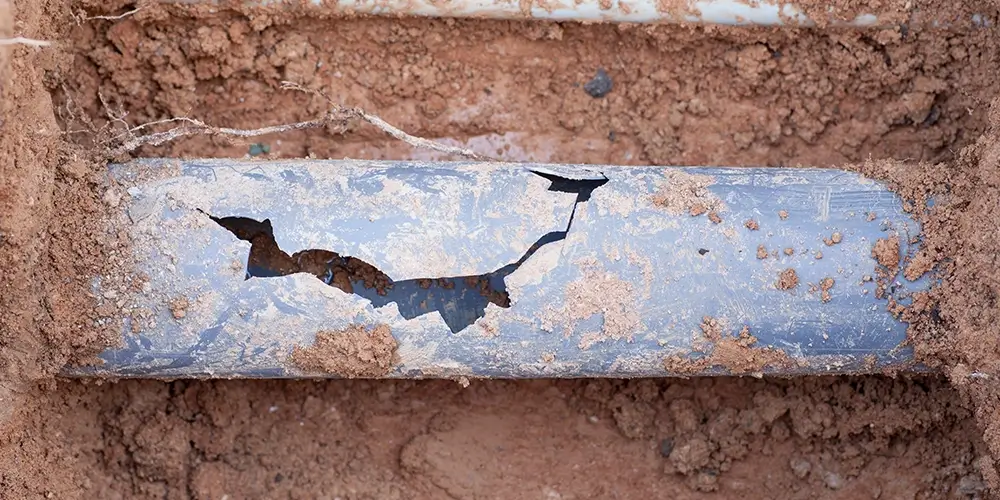In the world of plumbing, there are inconveniences, nuisances, and disasters.
A slow drain is an inconvenience. A collapsed sewer line can be a disaster, often involving expensive repair. It can lead to:
- Drainage problems
- Sewage backups
- Mold growth
- Structural damage to your home
What Is a Collapsed Pipe?
A “collapse” occurs when a pipe weakens and eventually fails, leading to a partial or complete obstruction. It rarely happens suddenly or to new pipes. Warning signs like small leaks or frequent blockages precede most collapses.
Sewer Line Collapse: the 10,000-ft View
The most common causes of a pipe collapse are:
- Corrosion and age-related deterioration
- Excessive weight or pressure on the pipe
- Improper installation
- Infrequent maintenance and cleaning
- Tree root invasion
- Soil movement
- Extreme weather conditions
- Exposure to harsh chemicals or acidic soil
What to Do If You Suspect Your Sewer Line Has Collapsed
Don’t wait! Call us, or call a plumber in your area. The problem never gets better on its own, and a collapsed pipe can:
- Damage your home’s foundation
- Pollute your home, yard, and the environment
- Create sewage and wastewater backups
- Flood your home
New technologies like trenchless repair and cured-in-place piping may enable us to repair a line quickly and without significant excavation. Only with an onsite visit can we make a diagnosis and devise a repair plan. And the longer you wait, the more likely the repair costs will climb. But what should you look for? How can take action before a plumbing disaster turns your life upside down?
These are the most common culprits of sewer pipe collapse, which can act separately or in concert.
1) Corrosion & Age-Related Deterioration
All plumbing materials have a limited lifespan. Your sewer pipes may last from 50 to 100 years, but wear and tear from hard water and harsh chemicals will accelerate corrosion. All pipes and weaken over time, leaving them vulnerable to collapse. Chemicals like acids, solvents, and saltwater can eat away at metal pipes until they give out under pressure.
High pH levels in water due to acidic soils or sewage discharge also lead to corrosion. Most homes built before the 1980s have pipes more likely to fail. It is an example of planned obsolescence, like the styling of your avocado-green refrigerator? No, the nice folks manufacturing pipes before 1980 weren’t greedy or malicious, but they had less know-how than modern manufacturers and less access to durable plumbing materials.
Popular materials in older buildings include tile, clay, and the notorious Orangeburg piping made from wood pulp and coal tar. Metal pipes are a decided improvement over Orangeburg and clay, but they corrode with age and exposure. Pipes made from tough PVC are less vulnerable to chemical corrosion than metal but may degrade faster in areas with high levels of UV radiation.
Under ideal conditions, these are the the approximate lifespans of the sewer pipe materials used most often in Orange County:
- Cast Iron: 50-75 years
- PVC (Polyvinyl Chloride): 50-100 years
- ABS (Acrylonitrile Butadiene Styrene): 50-100 years
- Copper: 50-75 years
2) Excessive Weight or Pressure on the Pipe
Too much weight on top of the soil surrounding a buried pipe can make it sag, shift, and break down. Heavy machinery can shift soil, putting excess pressure on the pipes below your slab. Take measures to protect old pipes if you’re having construction work done near your home. High water pressure from the street can also cause pipe failure. A plumber can check the pressure of your lines and make any adjustments.
3) Improper Installation
Improper installation can include:
- Using low-grade materials
- Poorly connected joints
- Improper backfilling of the trench
- Inadequate slope for drainage
- Not enough support for pipe runs over long distances
Before installation, the plumber should grade the soil and check for obstructions like roots or rocks. Sometimes lines are buried too shallow or placed in unstable soil. Shoddy trenching can create weak spots in the line.
4) Lack of Maintenance & Inspection
Pipes need regular cleaning and maintenance to prevent clogs and other problems from developing. Grease, hair, and other gunk and debris can create partial or complete blockages severe enough to collapse a pipe under its own weight (or when water pressure from heavy rains joins the mix). Schedule regular professional inspections, especially if you’ve experienced recent flooding or other water damage. Plumbers can detect weak spots in your piping system and take action before a collapse.
5) Tree Root Invasion
What did we learn in elementary biology? That trees have roots to:
- Anchor themselves
- Absorb water & nutrients
This constant search for water, especially in drought-stricken California, makes your water and sewage pipes attractive targets for thirsty trees. They work their roots into underground plumbing to grow and expand and exert ever-increasing pressure on a pipe until it fails. They can undermine any piping system, including iron and stainless steel. So if you have mature trees near your water or sewer pipes, be vigilant. Schedule preventive maintenance and root removal to protect your lines.
6) Soil Movement
Soil movement from earthquakes, mudslides, passing trains, and other forces can cause substantial shifts in the terrain, resulting in cracked pipes and collapsed infrastructure. This often happens during floods when soil becomes overly saturated with water, making it less stable and more prone to shifting. If you’re living in an area with an elevated risk of soil movement, have a plumber inspect your system once or twice a year.
7) Extreme Weather
Southern California isn’t known for temperature extremes, but sometimes a jump or dip of just 15 degrees Fahrenheit can cause big problems. High desert areas, in particular, are prone to extreme temperature shifts. When the warm air cools off quickly, it shrinks, creating a vacuum and sucking water out of pipes until they burst.
Prolonged low temperatures can freeze the ground; frozen ground can damage your pipes. On the other end of the spectrum, heat can cause plastic piping to expand too far and eventually break apart. Keep an eye on exposed pipes for signs of swelling or leaking in the summer months. In areas where temperatures stay cold or shift frequently, expect your pipes to have a shortened lifespan.
The Perfect Storm: When Many Problems Converge
These and other plumbing line problems can occur in tandem, or several factors may simultaneously undermine your pipes. If so, your poor sewer line doesn’t stand a chance. It absolutely will collapse, probably at the least convenient moment. Schedule regular maintenance to nip any potential problems in the bud. With preventative plumbing care and professional inspections, you can minimize the risk of pipe collapse and keep your system in peak condition.


